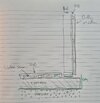Hi folks,
I'm in the early stages of building a 4m x 4.5m timber-framed garden office, and hope you can help with some questions about damp-proofing and attaching the frame to the foundation slab. I'm a fairly experienced DIYer, but this is the first time I've done something on this scale!
Proposed construction is as follows (Drawing attached):
1. Foundation: 150mm concrete ground slab, on top of DPM, sand blinding, and 100mm MOT Type 1 hardcore. I'm planning for the slab to be approx 100mm larger than the office floorplan all around, to allow for a margin of error. The finished slab height will be 100-150mm above ground level.
2. Floor insulation: 50mm celotex (or similar), infilled between 50mm timber battens laid over the concrete base. Overlaid with OSB, and internal floor covering (probably laminate/engineered wood) over the top.
3. Walls: 4x2 timber frame, for base wall plates/stud walls/top wall plates. These will be overlaid with OSB, vapour control layer, and clad over the top.
So, my questions are:
1. Is it ok for the concrete slab to be 100mm larger than the walls? I've heard conflicting advice on this - some saying it creates a surface area for water to pool and get under the building, while others saying it's structurally risky to fix wall base plates right on the edge of the slab. Thoughts?
2. Do I need a fall on the concrete slab? I was intending for it to be perfectly level, but have had conflicting advice from contractors about whether a fall is needed to prevent any moisture from pooling.
3. As mentioned above I'll have a DPM laid under the slab. What should I do with the excess that comes up the sides? Fixing this to the timber frame (perhaps underneath the cladding) springs to mind, as a way to avoid any moisture getting to the slab where it is larger than the walls. But that also seems like a potential route to funnel moisture up the walls, which wouldn't be great.
4. Do I need to lay a DPC between the wall base plates and the concrete slab, if I already have a DPM underneath it? I was planning to do so, as a belt-and-braces in case the DPM fails down the line. But keen to hear views.
5. If a DPC is needed, what type is best, and how can I best fix the wall base plates without ruining it? I was thinking of using a standard plastic DPC, and then using concrete bolts/screws to fix the walls to the slab. But I'm worried that piercing the DPC when doing so will make it less effective. Should the holes be sealed somehow, before fixing?
6. Do I need a similar DPC (or perhaps DPM covering the whole top of the slab), for the 50mm battens that support the internal floor and insulation?
Cheers in advance for your help!
I'm in the early stages of building a 4m x 4.5m timber-framed garden office, and hope you can help with some questions about damp-proofing and attaching the frame to the foundation slab. I'm a fairly experienced DIYer, but this is the first time I've done something on this scale!
Proposed construction is as follows (Drawing attached):
1. Foundation: 150mm concrete ground slab, on top of DPM, sand blinding, and 100mm MOT Type 1 hardcore. I'm planning for the slab to be approx 100mm larger than the office floorplan all around, to allow for a margin of error. The finished slab height will be 100-150mm above ground level.
2. Floor insulation: 50mm celotex (or similar), infilled between 50mm timber battens laid over the concrete base. Overlaid with OSB, and internal floor covering (probably laminate/engineered wood) over the top.
3. Walls: 4x2 timber frame, for base wall plates/stud walls/top wall plates. These will be overlaid with OSB, vapour control layer, and clad over the top.
So, my questions are:
1. Is it ok for the concrete slab to be 100mm larger than the walls? I've heard conflicting advice on this - some saying it creates a surface area for water to pool and get under the building, while others saying it's structurally risky to fix wall base plates right on the edge of the slab. Thoughts?
2. Do I need a fall on the concrete slab? I was intending for it to be perfectly level, but have had conflicting advice from contractors about whether a fall is needed to prevent any moisture from pooling.
3. As mentioned above I'll have a DPM laid under the slab. What should I do with the excess that comes up the sides? Fixing this to the timber frame (perhaps underneath the cladding) springs to mind, as a way to avoid any moisture getting to the slab where it is larger than the walls. But that also seems like a potential route to funnel moisture up the walls, which wouldn't be great.
4. Do I need to lay a DPC between the wall base plates and the concrete slab, if I already have a DPM underneath it? I was planning to do so, as a belt-and-braces in case the DPM fails down the line. But keen to hear views.
5. If a DPC is needed, what type is best, and how can I best fix the wall base plates without ruining it? I was thinking of using a standard plastic DPC, and then using concrete bolts/screws to fix the walls to the slab. But I'm worried that piercing the DPC when doing so will make it less effective. Should the holes be sealed somehow, before fixing?
6. Do I need a similar DPC (or perhaps DPM covering the whole top of the slab), for the 50mm battens that support the internal floor and insulation?
Cheers in advance for your help!


